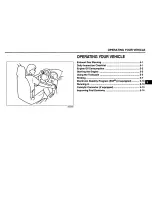
INTRODUCTION
PRELIMINAR STUDIES AND CONSIDERATIONS
MAINTENANCE AND DAMAGE PREVENTION
WORK ON BASIC VEHICLE
MOUNTING AND CONSTRUCTION
POWER TAKE-OFF
ELECTRIC AND ELECTRONIC SYSTEMS
APPENDIX
V1.0, February 2015
Body Builder Manual Part II, Specific Book LCV
241
7.5.3
Lighting system installation
For the safety of not only the person driving the vehicle, but also of all other road
users, the final vehicles must have lighting devices that are properly installed and
perfectly positioned. They must always comply with the current laws.
Therefore, it is advisable to pay special attention to the maintenance and adjust
-
ment of the lighting system. The Body Builder must check that the lamps, both the
original ones installed in the vehicle and any installed during conversion work, are
in perfect working condition before delivery of the vehicle.
The vehicle lighting system has two main functions, one passive and one active. On
the one hand it delimits the contours of the vehicle and makes it visible to other road
users, on the other it provides the driver with good visibility conditions, to enable
him to drive safely.
Accordingly, the lighting system of a vehicle can be categorised as:
- Optical signalling systems: end outline lamps, indicators, brake lights, lights used
by the emergency services and special services, etc.
- Illumination system: dipped beam headlamps, full beam headlamps, fog lights,
interior lamps, etc.
Lights and reflectors which are double and serve the same purpose will correspond
in colour and intensity, be located symmetrically and, if possible, at the same dis
-
tance from the edges of the vehicle.
No lamp installed in a vehicle should be flashing or with a variable intensity, except
for the signalling lamps specified in the current regulations and those for special
uses, for example in special-purpose vehicles. All illumination devices and optical
signalling devices in or on motor vehicles and trailers must meet the requirements
specified in the European regulation and any laws in force in each country. The in
-
stallation of other type of lights in vehicles is prohibited. The following points should
also be considered.
Headlamps and front fog lights
Their purpose is to sufficiently illuminate the road to a minimum distance ahead of
the vehicle. They must be properly installed and adjusted to facilitate adequate vi
-
sion for the driver without disturbing other road users. For correct headlamp ad
-
justment, the Body Builder should proceed according to the following
recommendations:
















































